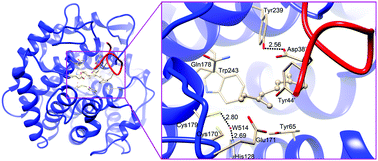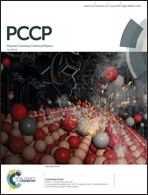Protonation state and fine structure of the active site determine the reactivity of dehydratase: hydration and isomerization of β-myrcene catalyzed by linalool dehydratase/isomerase from Castellaniella defragrans†
Abstract
Linalool dehydratase/isomerase (LinD) from Castellaniella defragrans is a bifunctional enzyme that catalyzes the hydration of β-myrcene to (S)-linalool and the isomerization of (S)-linalool to geraniol. In this paper, on the basis of recently obtained crystal structures, the catalytic mechanism of LinD has been explored by a combined quantum mechanics and molecular mechanics (QM/MM) approach. Two computational models have been constructed. Model I (LinD-linalool) was derived from the crystal structure of the selenomethionine derivative of LinD (Semet–LinD) in complex with the natural substrate geraniol, whereas model II (LinD-β-myrcene) was constructed from the crystal structure of LinD in complex with β-myrcene. In addition to a minor conformational difference of the active sites, the two models also differ in the protonation state of key residues. In model I, the pocket residue Asp39′ was set to be deprotonated and His129 was protonated on ND1, whereas in model II, Asp38′ was set to be deprotonated and His128 was protonated on NE2. Our calculations reveal model II as the active one, which implies that hydration and dehydration are sensitive to the protonation state and fine structure of the active site. On the basis of model II, the conversion details from β-myrcene to geraniol can be obtained. Firstly, β-myrcene is hydrated by a crystal water (W14) and is converted into the stable intermediate (S)-linalool, then linalool is isomerized to geraniol with an overall energy barrier of 24.6 kcal mol−1. Besides, linalool can also reversibly convert into the reactant with an energy barrier of 24.1 kcal mol−1. It is also found that the intermediate IM1 can directly transform to geraniol without first converting to (S)-linalool. His128 and Tyr65 form hydrogen bonds to stabilize the structure of the active site, but they do not act as general acid/base catalysts during the catalytic reactions.



 Please wait while we load your content...
Please wait while we load your content...